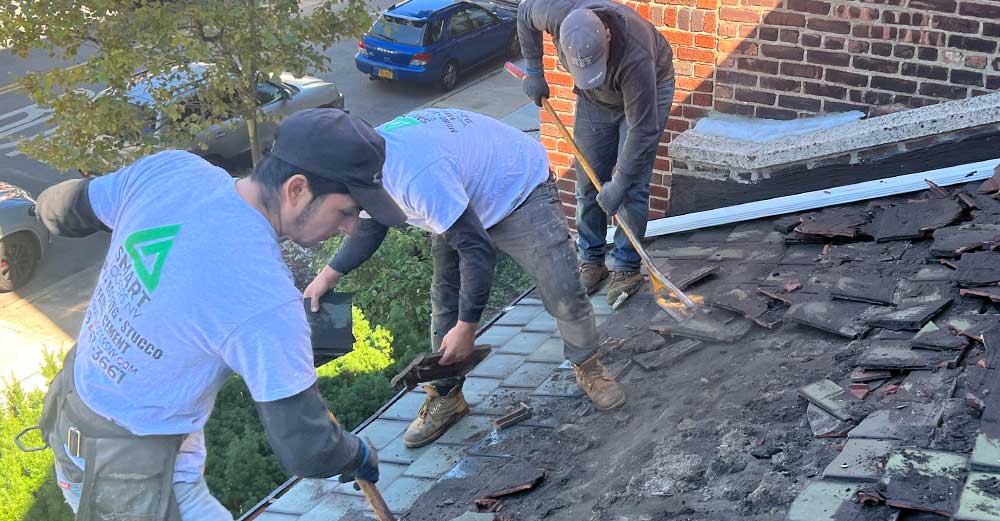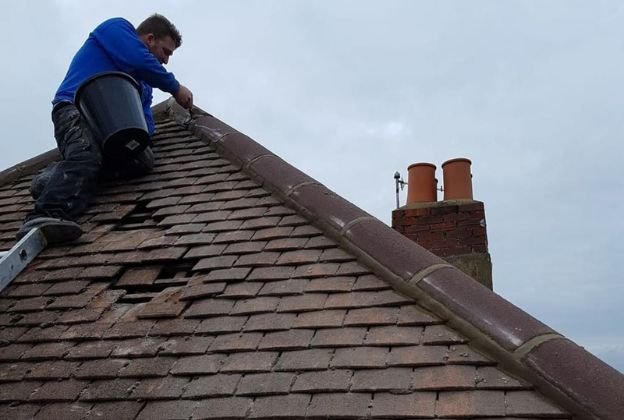Comprehending the Various Kinds Of Roofings: A Comprehensive Guide for Homeowners
With a selection of options-- ranging from the typical gable to the modern flat-- each type presents special benefits and obstacles that need to line up with the house owner's particular needs and environmental factors to consider. As we discover the ins and outs of different roofing system kinds, it becomes obvious that one dimension does not fit all; the right choice might shock you.
Gable Roofs
Saddleback roofs, characterized by their triangular shape, are among one of the most prominent roof covering styles because of their simplicity and effectiveness in shedding water and snow. This style includes two sloping sides that satisfy at a ridge, permitting reliable water drainage and minimizing the danger of water build-up. The high pitch commonly related to gable roof coverings boosts their ability to take care of hefty precipitation, making them ideal for various climates.
In addition to their sensible advantages, gable roofing systems offer visual flexibility. They can be adjusted to numerous architectural designs, from standard to modern-day homes. The style can additionally accommodate extra features such as dormer windows, which improve all-natural light and air flow in the attic area.
Furthermore, gable roofs provide ample space for insulation, adding to energy performance. House owners can pick from a variety of roofing materials, including asphalt roof shingles, steel, and tiles, even more enhancing personalization choices.
Despite their advantages, saddleback roofs might require extra support in areas susceptible to high winds or hefty snowfall. On the whole, the saddleback roof remains a popular option because of its mix of performance, toughness, and visual appeal.
Apartment Roofs
Level roofs are often identified for their minimalist design and useful applications, particularly in industrial and commercial settings (oahu roofing). These roofs feature a straight or almost straight surface area, which enables simple building and flexible area usage. While they might do not have the visual appeal of angled roofs, level roof coverings use various benefits, specifically in city settings where optimizing room is critical
Among the key benefits of level roof coverings is their ease of access. House owners can use the roofing system room for numerous functions, such as roof gardens, balconies, or solar panel setups. Furthermore, level roofs are typically extra cost-effective to maintain and mount compared to their sloped counterparts, as they call for less materials and labor.
Nonetheless, level roofs do existing certain challenges. Correct drain is important to stop water merging, which can cause leaks and architectural damages. For this reason, picking top quality waterproofing materials and normal evaluations are vital for guaranteeing long life. Usual products made use of for flat roof coverings consist of built-up roof covering (BUR), modified asphalt, and single-ply membranes, each offering distinctive benefits. On the whole, flat roofs work as a useful and adaptable selection for numerous house owners and businesses alike.
Hip Roofing Systems
Hip roofing systems are characterized by their sloped sides that assemble at the top, developing a ridge. This layout stands out from gable roofs, as all 4 sides of a hip roof slope downwards toward the wall surfaces, providing an extra steady structure. The angle of the slopes can vary, permitting for convenience in building visual appeals and capability.
One of the primary benefits of hip roofs is their capacity to stand up to heavy winds and unfavorable weather. The sloped surfaces go now enable far better water drain, reducing the threat of leaks and water damage. Furthermore, hip roofing systems provide raised attic room room, which can be used for storage or also converted into livable areas.
Nevertheless, building a hip roof covering can be more expensive and intricate than easier roof covering kinds, such as saddleback roofs. The additional product and labor included in developing the slopes and making sure proper architectural honesty can cause higher expenditures. In spite of these drawbacks, many house owners prefer hip roof coverings for their sturdiness, aesthetic appeal, and capacity for energy effectiveness.
Mansard Roofing Systems
Mansard roof coverings, typically acknowledged by their unique four-sided style, function 2 inclines on each side, with the lower slope being steeper than the upper. This architectural style, originating from France in the 17th century, is not only aesthetically attractive yet practical, as it takes full advantage of the useful area in the top floorings of a structure. The steep lower incline enables more headroom, making it an optimal option for attic rooms or lofts, which can be exchanged living areas.
Mansard roofings are identified by their adaptability, fitting various building styles, from standard to modern-day. They can be created with various products, consisting of asphalt tiles, slate, or steel, offering property owners with a range of options to suit their budget plans and choices. Furthermore, the layout enables the combination of dormer windows, enhancing all-natural light and ventilation in the top levels.
Nevertheless, it is vital to take into consideration the possible disadvantages. Mansard roofings may need even more maintenance due to the complexity of their design, and their steep inclines can be challenging for snow and rain runoff. In general, mansard roofings integrate sophistication with usefulness, making them a prominent choice among homeowners looking for unique architectural functions.
Dropped Roofs
As homeowners significantly seek simplicity and capability in their architectural designs, shed roofs have become a prominent choice. Identified by a solitary sloping plane, a shed roof anchor provides a minimal visual that complements various home designs, from modern to rustic.
One of the main benefits of a shed roof covering is its simple building, which usually translates to decrease labor and product prices. This style enables for reliable water drain, minimizing the danger of leakages and water damage. Additionally, the vertical incline provides adequate room for skylights, improving natural light within the interior.
Shed roofing systems likewise provide convenience in terms of use. They can be properly incorporated right into additions, garages, or outdoor structures like structures and sheds. Additionally, this roof style can accommodate numerous roofing materials, including steel, asphalt shingles, or perhaps green roofs, straightening with eco-friendly initiatives.
However, it is necessary to consider regional climate conditions, as heavy snow lots may demand modifications to the roofing's angle or structure. Overall, dropped roofs provide a useful and cosmetically pleasing alternative for home owners wanting to make the most of performance without endangering check it out style.
Conclusion


Gable roofs, characterized by their triangular shape, are among the most popular roof covering styles due to their simplicity and effectiveness in shedding water and snow. oahu roofing. The steep pitch commonly linked with gable roofings boosts their ability to manage heavy rainfall, making them ideal for numerous climates
While they may lack the aesthetic charm of pitched roofing systems, level roofing systems provide various advantages, particularly in city settings where maximizing area is essential.

Comments on “Roof Repair Oahu: Quick and Affordable Roof Repairs Near You”